Michelle Ferrier
“Creativity, as has been said, consists largely of rearranging what we know in order to find out what we do not know. Hence, to think creatively, we must be able to look afresh at what we normally take for granted.”
— George Kneller, author of The Art and Science of Creativity
How do you know if your good idea is the next big thing? Whether you are an intrapreneur, working within an existing business, or an entrepreneur looking to create a business startup, or a student creating an idea for a class project, this question is the one that should drive you to find answers. Unfortunately, it is not a question that can be answered on its own. It takes answering a bunch of other questions of your potential customers, of your own motivations, and of your idea as well. Two key qualities required to begin this journey include curiosity and creativity. As a communicator or a student at a mass communication program, you should already possess an innate curiosity about people, storytelling, and problem solving. Creativity is a skill that can be cultivated as an individual or as part of group or team exercises, to develop unusual connections, breakthroughs in processes, or insights that lead to product development. Often, the journey to a good idea begins with asking “What if?”
Ideation is the process of coming up with an idea. It is using creativity and questions like “What if?” to imagine ways something can be done differently. The ideation stage is critical to ensure that you are generating good ideas from the start. It involves seeing problems and opportunities, brainstorming around the problems you identify, and doing research to test your assumptions about the market, your customers, and your idea. Refining that initial idea involves assessing the market, looking at trends, and asking questions (and more questions)—and learning from potential customers, investors, and research whether your idea is a good one. The design process consists of a series of steps to test assumptions and ideas. Ideation falls within a larger design process that begins with understanding who you are serving; empathizing, understanding, and defining the needs of that target audience; then ideating around what is needed (Figure 1):
In the Stanford School Design Thinking Process, there six stages to design[1]:
- Empathizing
- Defining
- Ideating
- Prototyping
- Testing
- Sharing
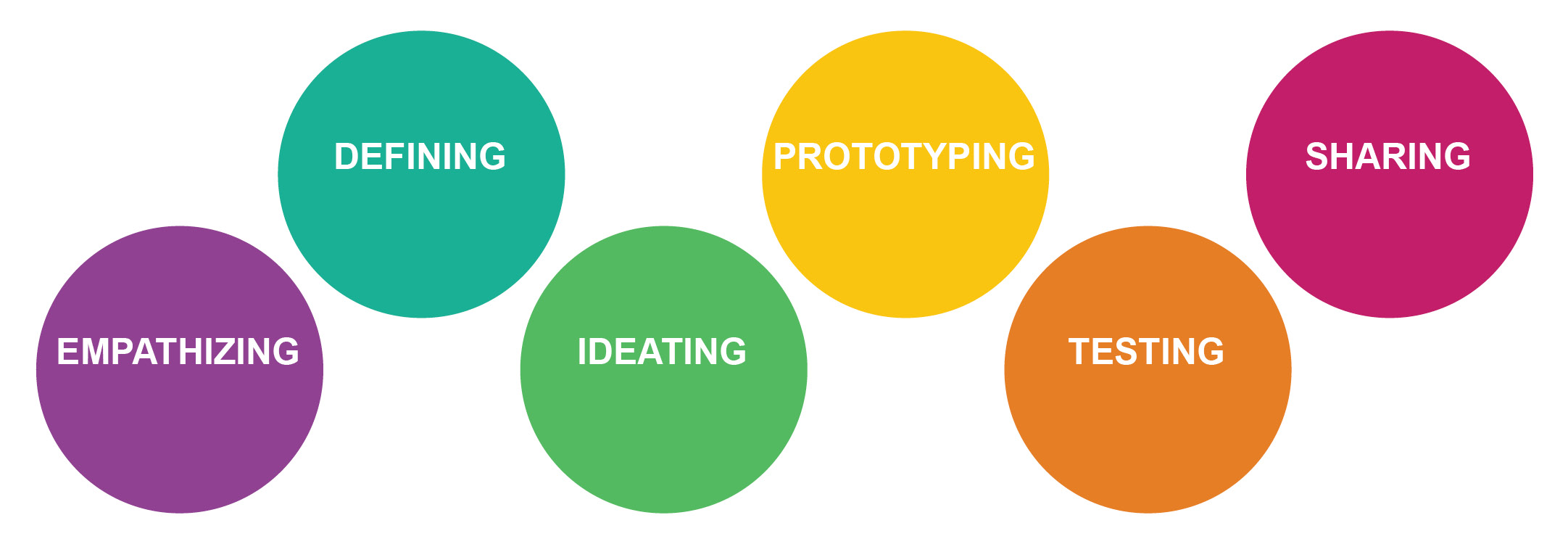
According to 2012 research by Harvard Business School instructor Shikhar Ghosh, 75% of venture-backed startups fail.[2] Ideas are like opinions—everyone has one. If the founders of those failed companies could have answered that question as to whether their idea was the next big thing…well everyone wants that guarantee. But entrepreneurship is risky. Startups are risky. You and your team are using your time and your intellectual property (ideas) to create something new. Generating a great idea from the start is part of a larger set of success factors such as the expertise of the founders, the competitive landscape, speed to market, and other factors.
These other success factors include:
- The composition of the team itself;
- The execution of the concept. Is the team adaptable, effective and efficient?
- The structure or business model shows a clear revenue path and immediate revenue stream;
- The structure of funding; and
- The timing of the idea and its entry into the marketplace.
What ultimately matters most is not the idea, but the ability of the team to work together, execute and test an idea, and get their idea out into the marketplace. So the ideation stage is about minimizing the risk of failure by coming up with ideas that the world needs or wants. Successful startups begin with a quality idea, one that is novel, encapsulates a “truth,” and will have good barriers to competitors.
Students will often come to me and say, “I’ve got this great idea, but I’m afraid to share it because someone might steal it.” I often coach students that their fear is preventing them from finding other teammates, coaches, potential investors, and mentors. Timing and execution are king; ideas, well, everyone has one. So if you’re hoarding your ideas, you are limiting one of your key assets, which is timing.
Is an idea something that can be protected? Ideas themselves cannot be copyrighted, but original expressions of ideas in a tangible medium can earn legal protection. Review the following resources to understand what can and can’t be protected under U.S. copyright, patent or trademark law.
- FAQs About Copyright, United States Copyright Office, https://www.copyright.gov/help/faq/index.html[3]
- Patent FAQs, United States Patent and Trademark Office, https://www.uspto.gov/help/patent-help[4]
- Trademark FAQs, United States Patent and Trademark Office, https://www.uspto.gov/learning-and-resources/trademark-faqs[5]
But what if you don’t have a great idea? How do you practice stretching your imagination to be more creative? And what is creativity anyway? A recent article in the alumni magazine for the University of Central Florida[6] spoke to the entrepreneurial culture that has been a part of the DNA of the institution since its founding as a technical school in 1963. Administrators and faculty from all types of disciplines were asked to weigh in. Michael Pape, Dr. Phillips Entrepreneur in Residence, says creativity is the hunt for an answer to a secret:
“Creativity is a process of bringing something new into existence that challenges prevailing assumptions. It’s fundamental to human existence. To challenge prevailing assumptions, you need to discover secrets.” Pape says “to observe, embrace chaos, and try to frame it into form, you might uncover those secrets in the process.”
Rick Hall, production director for the Florida Interactive Entertainment Academy, says that creativity is a teachable skill.
“Creativity is really just your ability to associate two disparate ideas in a way that others haven’t thought of before. You’ve got to proceduralize creativity. And never let a good mistake go to waste.”
I once interviewed a student at the University of Pittsburgh who got involved in entrepreneurship because he thought himself to be someone who was creative.
“I always wanted to pursue new ideas,” he said. “It just seemed like the current system is kind of rigid in the sense that the older you get, the more you have to start pruning away some of your ideas and get a more precise focus. And for me, I kind of like things open-ended, and I like to really explore all these ideas that I feel is like part of one big puzzle. And when you put that together, that’s how you get the best products because it draws from a number of inspirations.”
Scanning the Environment
Pape says the creative process begins with observation. As a curious journalist, I am always on the lookout for problems, opportunities and new ideas, observing what is happening around me, listening to what my neighbors are talking about, and what people are struggling with in their everyday lives. And as Hall suggests, we can “proceduralize creativity” by increasing the juxtapositions, the opportunities for the collisions of disparate ideas that might spark the next idea.
As an avid reader and a bit of a science geek, I am always scanning publications inside and outside my field that feature innovations in science, medicine, technology, and journalism such as Wired, FastCompany, and Scientific American. First, I’m learning about innovations and how others leveraged their ideas into businesses. Second, I’m learning how founders adapt their ideas as they learn. Third, I begin to see the world through others stories, experiences, and disciplines that help me to “look afresh” at the world as George Knelle suggests.
Scanning the environment like this is what led me to create Troll-Busters.com in 2015 as I observed what was occurring in social media spaces online and the challenges of women journalists and journalists of color in maintaining a voice online in the midst of targeted online harassment. While the idea began because of my own personal experience and the current news of Gamergate attacks,[7] I quickly validated that this was a common experience among journalists and media organizations. The idea for TrollBusters was validated initially by the response from female journalists themselves at a hackathon. However, we quickly began diving into global scholarly research that further pointed to the scope and scale of the problem we were addressing.
Through deep interviews with women journalists, we discovered a reluctance to report abuses and a lack of knowledge about what to do next after an attack. The interviewees also talked about the lack of support from peers and management. We started by developing awareness campaigns and online courses that made visible what was happening all over the world and helped women journalists take control of their own protection and speak up about the online harassment they are experiencing.
Look to the work of futurists and others who attempt to predict the future of technology, education, manufacturing, and other fields. Amy Webb,[8] founder of the Future Today Institute, examines trends in technology, media, and communications. In her new book, The Signals are Talking,[9] she says there are “signals” that everyone can watch for, beyond what is covered in the technology press. She says “It’s not like there’s a singular source where you would go to find the unusual suspects at the fringe. Instead, it’s a series of guiding questions she uses in her explorations:
- Who do I know of that’s been working directly and indirectly in this space?
- Who’s funding this work?
- Who’s encouraging experimentation?
- Who might be directly impacted if this technology succeeds one way or the other?
- Who could be incentivized to work against any change?
- Who might see this technology as just the starting-off point for something else?”
Then the curious, like Amy, get going. They start asking questions. And reading. And listening.
The New Media Consortium started asking these questions of its employees, who were trying to keep up with the changing technology landscape. They realized that many policy makers, industry leaders, innovators, educators, and others struggled to keep up with technology trends. They started the NMC Horizon Project[10] to chart emerging technologies and their implications for teaching, learning, and creative inquiry. (Note: They have ceased operation, but the reports[11] are still available. Accenture, a strategy and consulting company, creates a technology trends report. Its 2017 Technology Vision[12] report details disruptive technology trends and deep industry knowledge. CBInsights tracks trends across multiple industry sectors including automotive, financial tech, the Internet of Things, artificial intelligence, AR/VR, and other technology areas.
In the media field, I’ve mentioned publications like Wired and FastCompany that provide a deep dive into media and technology innovations. The Pew Research Center[13] offers deep research into social, religious, technology, and media trends and usage. Other media-focused publications include MediaShift, TechCrunch, Mediagazer, and VentureBeat.
CrunchBase is a database of startups, product development timelines, funding rounds, and other information. Add in subscriptions to online newsletters for the startup and entrepreneurship world like Entrepreneur and Fast Company, Inc. and others to keep an eye out on emerging, competing ideas in the market. Find these types of sources and scour them to cultivate new ways of seeing the world, the first step to creating innovative ideas.
Thinking Creatively With Human-Centered Design
LUMA Institute defines human-centered design: “Human-Centered Design (HCD) is the discipline of developing solutions in the service of people.”[14] Human-centered design (HCD) is being adopted now by more organizations, strategists, and development practitioners and has been taught in places like Stanford’s D-School (Design School). HCD views people as the core focus of design and development. According to LUMA Institute,[15] which works with organizations seeking to innovate:
“Every story of a good innovation — whether it’s a new product, a new service, a new business model or a new form of governance — begins and ends with people. It starts with careful observation of human needs, and concludes with solutions that meet or exceed expectations.”
When I teach innovation, I separate the Human-Centered Design process into three phases:
- Inspiration Phase: Learn directly from the people you’re designing for as you immerse yourself in their lives and come to deeply understand their needs.
- Ideation Phase: Make sense of what you learned, identify opportunities for design, and prototype possible solutions.
- Implementation Phase: Bring your solution to life and eventually to market. And you’ll know that your solution will be a success because you’ve kept the very people you’re looking to serve at the heart of the process.
Individuals, teams, and other groups use brainstorming and ideation to come up with better ideas — ideas that speed processes, ideas that create new products, ideas that create innovations, and ideas that solve problems. But usually that activity happens in a vacuum —a team sits around a whiteboard coming up with ideas. With human-centered design, inspiration comes through exploration of actual people, their problems, and their needs. So ideation is like an incubator for experimentation. The better you become at asking questions of potential customers and getting them answered quickly, the better you can be at shaping your idea into something that meets a need.
Ideation also involves knowing your outcome/deliverable. If you are creating ideas for a student competition, you’ll want to know the rules and what the judges will be evaluating. Some competitions give you the problem you are attempting to solve. Your measure of success will be in how closely your idea aligns with the competition goals. I’ve often judged student competitions where there are different rubrics. The simplest I’ve used asks founders to ask themselves three questions:
- Feasibility: Can we do this?
- Viability: Should we do this?
- Desirability: Do they want this?
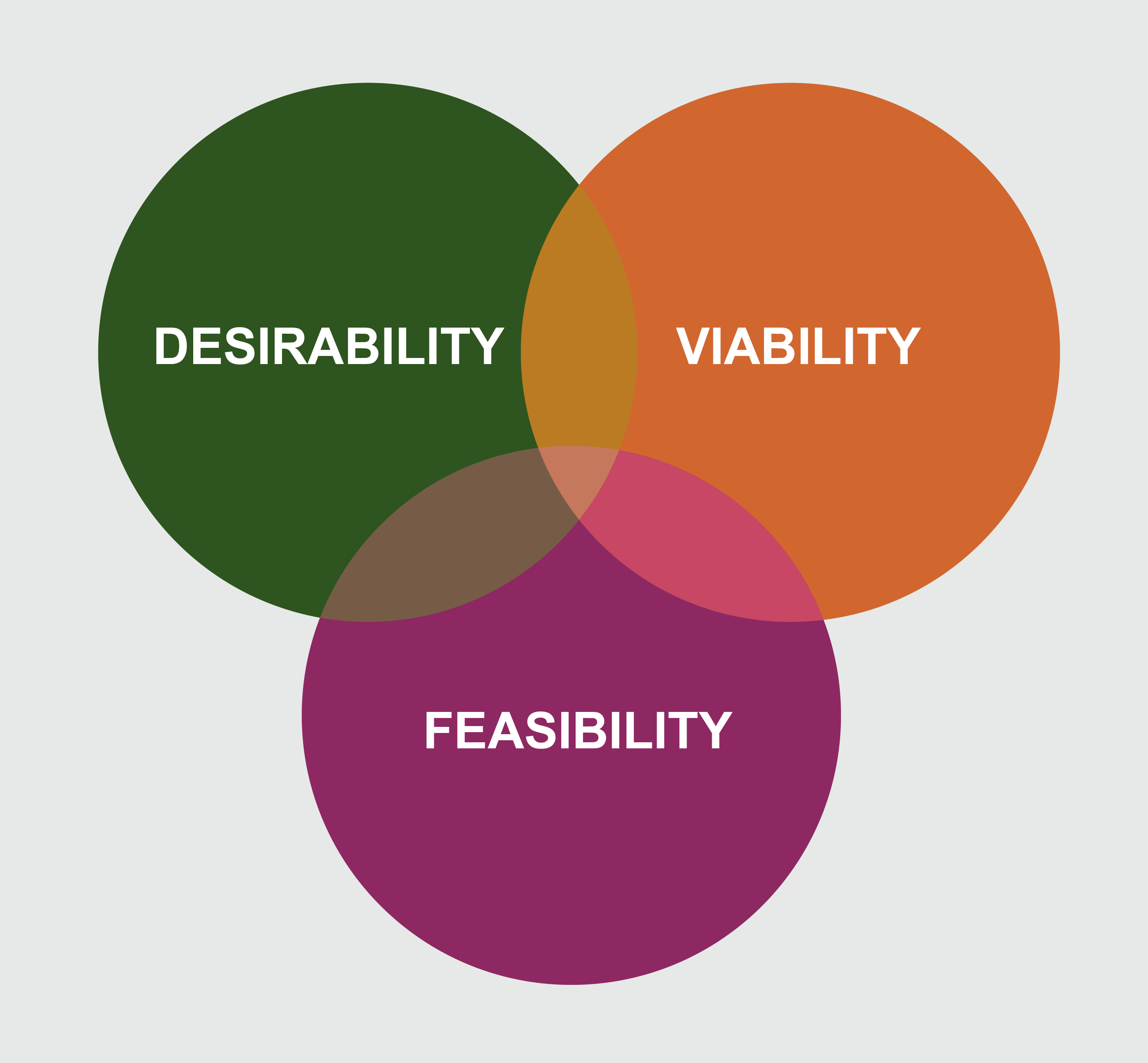
The most valuable design sits at the intersection of these three questions and will help guide you in positioning your ideas to meet market needs.
The rubric I developed for an international innovators cup competition provides a good template to use to determine if your idea is innovative:
- Presentation was compelling, easy to understand, and described the problem and a “fresh” solution.
- Meets the threshold for innovation. Judges should be guided by the reality that truly transformational innovation is rare. Incremental innovation is more the norm but is equally valuable in our competition so long as it provides an inspired solution to the challenge that has been posed.
- Takes full advantage of new media tools, platforms, technologies, and applications in use today. These might include things like interactive design, gaming, geolocation-based tools, informational graphics, and all aspects of social media, etc.
- Addresses the problem within its context. It should demonstrate that it is offering an idea or approach that is supported by facts and/or research and demonstrates an understanding of today’s media and communication landscape, including familiarity with any similar products, apps, or services.
- Understands possible roadblocks, competition, and need for a sustainable advantage. The solution shows an understanding of the roadblocks that need to be overcome, the competition, and how the solution can be sustainable.
- Provides a solution that clearly describes its main features and benefits and presents a valid value proposition with the key activities clearly outlined.
I also added this “diversity enhancement” component to the competition questions to ensure student teams thought about and integrated the needs of underserved and underrepresented users/customers/audiences in their solutions.
- Solution embraces diverse viewpoints, populations, or audiences. The solution realistically includes the potential to expand media diversity, including serving underserved populations:
Later in the chapter, we’ll look at specific team exercises to get your group thinking expansively, increasing the juxtaposition of disparate ideas, and generating ideas that we can test. But first let’s examine the media landscape and see if we can find interesting juxtapositions and questions that can help us find novel ideas.
The Media Innovation Landscape
Media innovation and entrepreneurship brings together journalism, technology, and business to create new projects inside and outside of traditional media organizations. For the media industry, there are significant opportunities in the disruption to business models and technological changes. This seismic shift in the monolithic news and information business has created a landscape that has allowed new forms of journalism and technology to emerge, driven by innovation, creativity, and entrepreneurship. The report “The Big Thaw: Charting a New Future for Journalism” by Tony Deifell of Q Media Labs[16] details the new competitive landscape for today’s media enterprises (Figure 3).
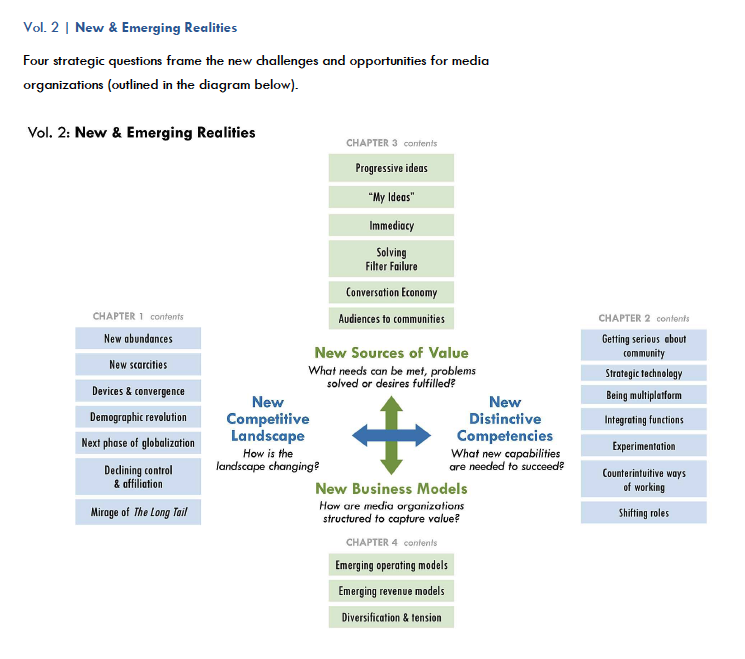
As Deifell’s report describes, this disruption can be seen as opportunity. Each of the four areas: new competitive landscape, new sources of value, new distinctive competencies, and new business models presents challenges, questions, and spaces providing fertile ground for new ideas. His four questions challenge us to continue to look to the media industry and communication professions for opportunities by asking ourselves:
- How are media organizations structured to capture value?
- What needs can be met, problems solved, or desires fulfilled?
- How is the landscape changing?
- What new capabilities are needed to succeed?
For example, look under “New Competitive Landscape.” The media industry has had to respond to new devices and convergences. Existing companies have had to innovate and design products to maximize the mobile experience for users of their content and products. Think about news apps such as BBCNews[17] for traditional news entities that expanded their existing brand into a new device. We can also point to startups like FlipBoard,[18] a tool designed solely to solve the problem of making reading content easier on a mobile device. Mike McCue, the founder of FlipBoard, says he never intended to start another company after he sold his prior company TellMe to Microsoft. His new company started by asking the question “What if?” that started him thinking about redesigning the web interface from scratch.
The mashup of disciplines and technology yields new forms of media entrepreneurship. The chart from The Big Thaw: Report on New Competitive Landscape, p.11 (Figure 4) shows the new media paradigm that is driving these changes.
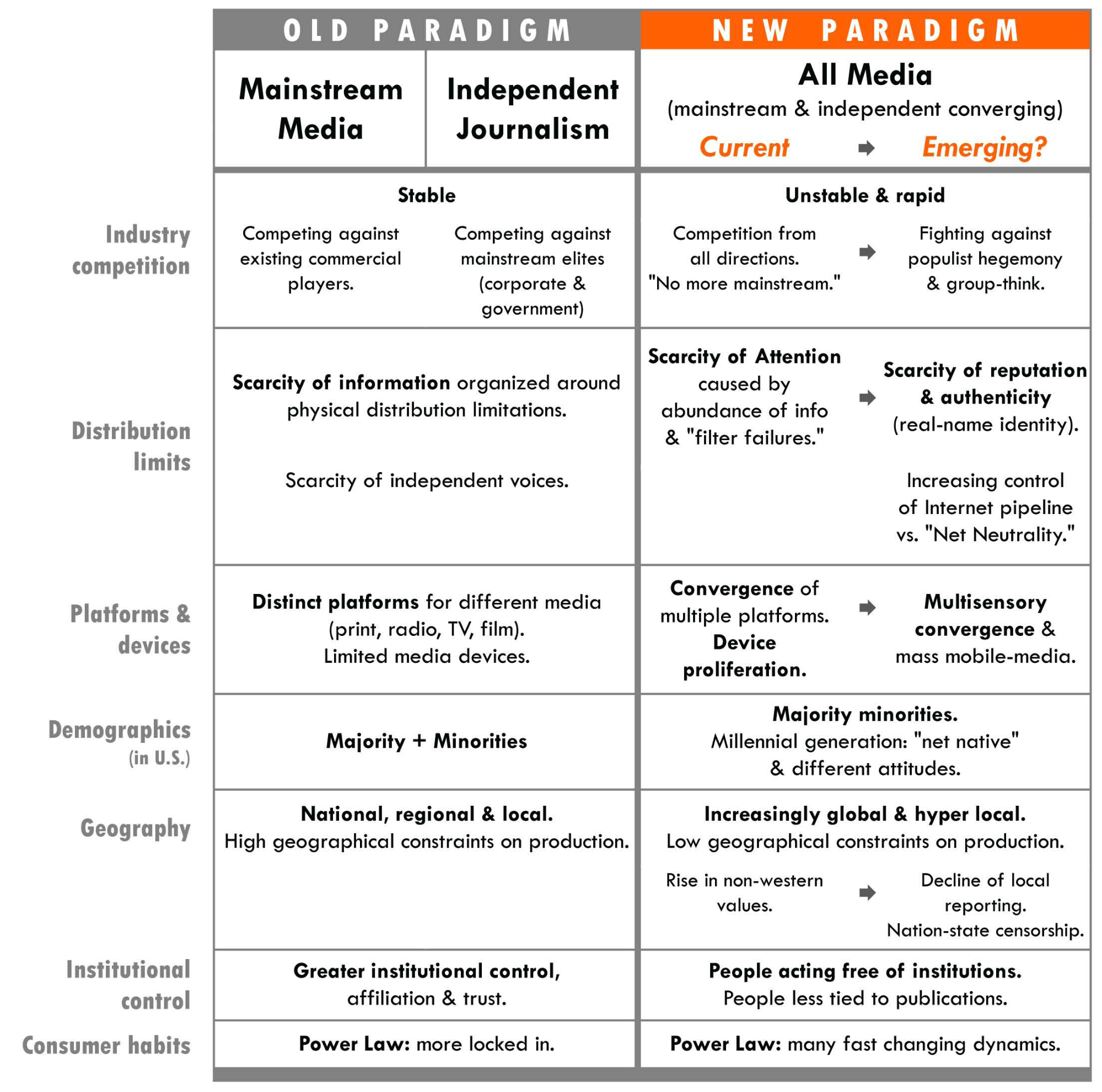
It was at the intersection of three disciplines — business, nutrition, and journalism — that I developed the idea for LocallyGrownNews.com, which won a News Media Women’s Entrepreneur grant of $20,000 from the McCormick Foundation in 2009. The idea — Women’s Community News Franchise — provided the infrastructure—technical, education, writing, publishing, software, and advertising support — to develop online community news and information franchises. Citizen journalists and community members can focus on what they are most passionate about — building their community conversation through good local information and networking.
The business structure for LocallyGrownNews.com came from the franchise business model of providing services and growing a prototype model. The content topic came from the local food movement that was gaining favor nationwide. Geography and journalism became my way to solve the problem of access to fresh, local food. How could I help people live a local food lifestyle through LocallyGrownNews.com? By providing a website with information about local producers, farmers markets, and timely alerts of seasonal goods, I was able to solve the problem of getting good information about the local produce market to my audiences. I’d found a niche at the intersection of the growing local food movement, distributed networks of content creators, services, and a need for good information.[19]
Defining the Problem Space
Before you design a solution, you need to know what problem you are trying to solve. I often have students who want to create startup ideas that solve a personal problem. One of my students wanted a better way to share music. Another wanted to create a way to earn Boy Scout merit badges online. However, each of these students needs to define the problem space to determine whether their solutions—online education and peer-to-peer recommendations—were really a problem for other people. In other words, is this problem a pain point for just you or are there others? Is there a real problem with a large enough market that needs a solution? To define the problem space, we need to start with a more expansive view of what we are dealing with to determine what might be the best solution.
Remember the three questions we asked earlier in the chapter?
- Feasibility: Can we do this?
- Viability: Should we do this?
- Desirability: Do they want this?
At this point in the process, we are trying to answer the desirability question…Do they want this? So we have to define who is the “they” in this question, and then brainstorm to discover the “this” or solution in the question we want to test. We can use human-centered design to experiment and match our solutions to customer needs at the sweet spot in the center of feasibility, viability, and desirability.[20]
Working the Problem Space
So let’s say you are trying to develop concierge college admissions services. That’s the business you want to create. But what is the problem you are trying to solve? Often, students jump to a solution before diving deeply into understanding the problem space. Who is experiencing pain? Is it painful enough that people are seeking solutions and willing to shell out money?
Stanford University’s D-School has developed exercises for brainstorming and developing ideas. LUMA Institute and IDEO.org are two additional companies that help organizations think more expansively and deliver ideas that meet human needs.
Stakeholder Mapping
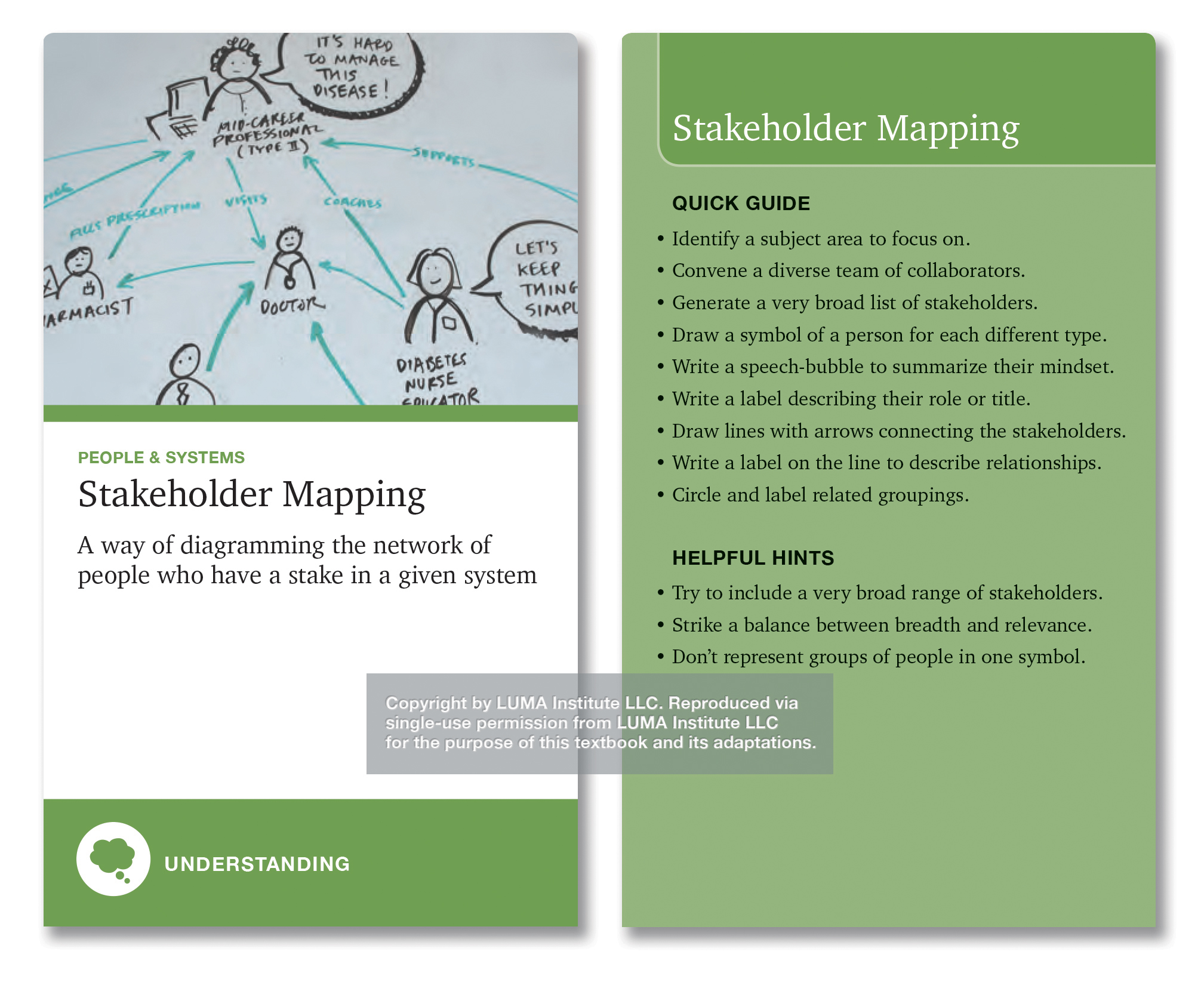
To visualize who is impacted by the problem you are trying to solve, you can use a stakeholder map to get a sense of the problem space, the actors in it, and who your solutions might address.
For example, students in a social media class were attempting to create tools and strategies to reach out to potential undergraduate students for college admissions. Of course, they started with the pain points and perspective of high school students having recently been in the search for colleges themselves. However, by identifying other stakeholders that play a role in the admissions process, the students were able to identify other pain points and possible solutions that addressed parents, admission counselors, and other stakeholders in the map (Figure 6).
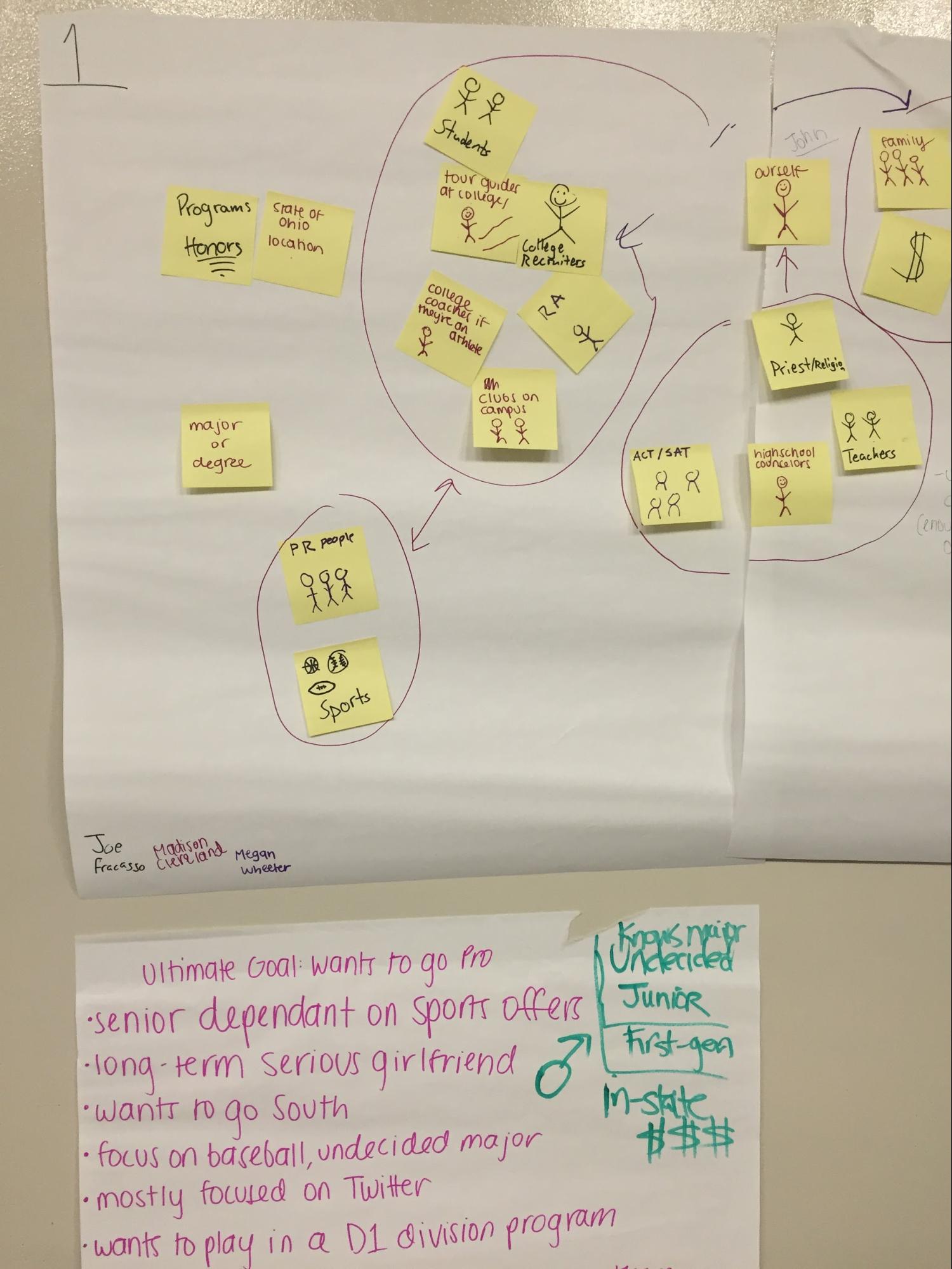
To begin, you need stickies and limited drawing ability. Also a large blank canvas of paper.
- Create small teams of two to six people. Each person in the team gets sticky notes and a marker.
- Independently, team members are invited to brainstorm potential stakeholders in the problem space. In our example above, we went beyond the college organization to look at the role of parents, high school counselors, government agencies, and others play in the college decision process. Individual work should be given about one minute.
- Collectively, the team goes through its stakeholders, identifying commonalities and defining the roles more clearly by adding a visual element or a speech bubble to suggest what the person may be saying or thinking. These stakeholder stickies are put up on the blank canvas by consensus of the group.
- Organize the stakeholders by grouping entities that are linked by geography or processes. Use lines to draw relationships between stakeholders. For example, a line between parents and the financial aid office of a college might be drawn with dollar signs on it.
- Discuss in the group where there are breakdowns, pain points, and other places where innovation might help to solve the problem. These discussions can then be used to refine who the customer might be for your efforts — students, parents, college administrators, etc. — and who will pay for your solution.
- Select the stakeholders that you will continue to ideate around as potential customers.
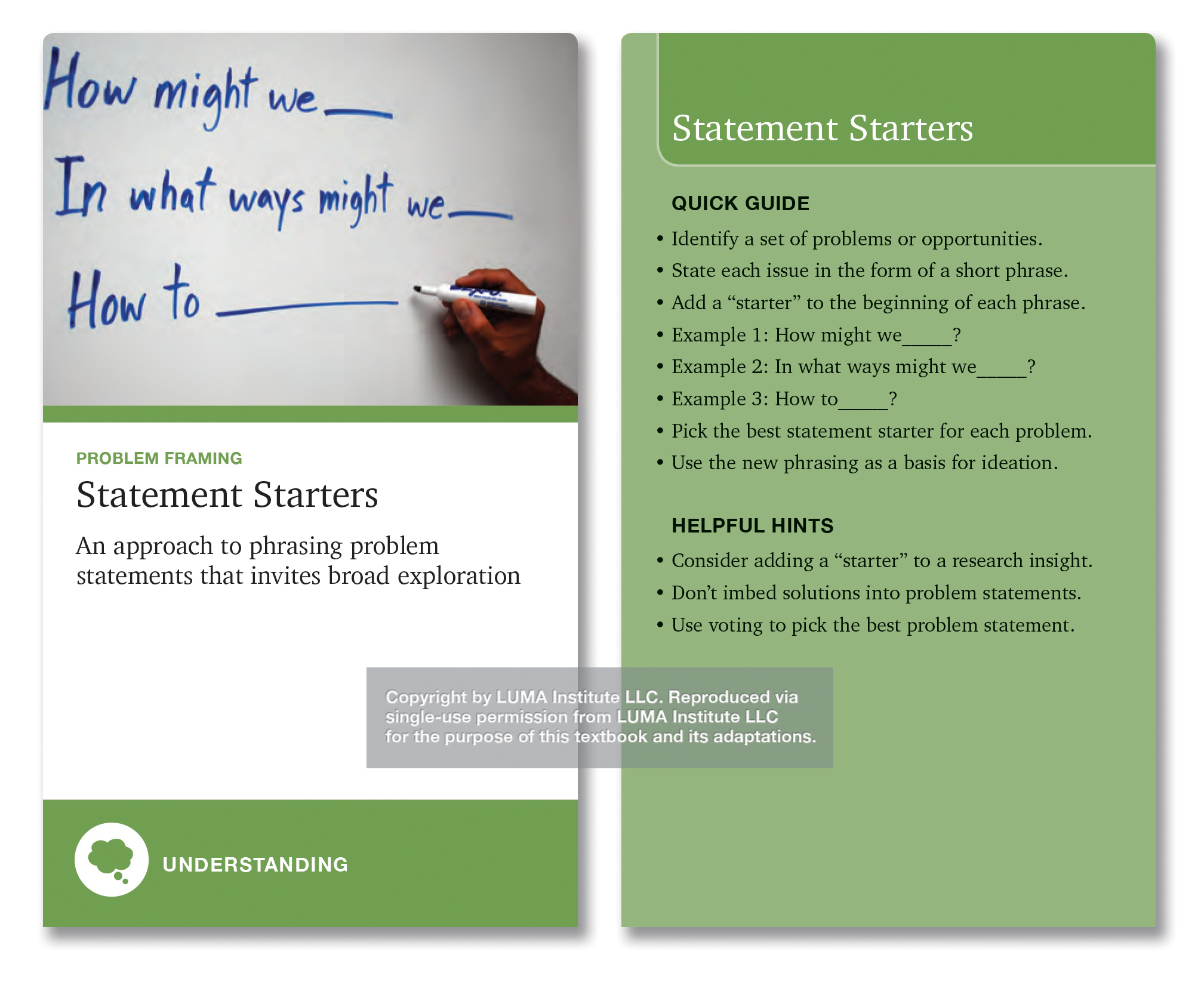
Statement Starters
One exercise, found at LUMA Institute,[21] is designed to ask “What if?” types of questions: open-ended questions that become the jumping point for brainstorming. Sample statement starters include: What if_____? or How might we_____? These statement starters are then attached to the problems you’ve identified in your stakeholder mapping exercise. Brainstorming then happens around the problem you’ve identified.
IDEO has a design kit[22] with many examples.
Other Tools You Can Use
- IDEO’s Design Kit resource[23] will help you work with students in brainstorming exercises like the Mash Up which encourages students to think outside of the box to create brilliant proposals and solutions.
- Check out this collection of Human-Centered Design methods[24] you can use to guide students in the ideation phase.
- LUMA offers an online platform[25] to help people implement Human-Centered Design using LUMA’s “flexible, repeatable and easy-to-learn” system of Human-Centered Design.
- Exploring your hunch[26] is a huge part of Human-Centered Design. Here is a useful tool to get those ideas and creative juices flowing by exploring and testing your hunch.
- The card game Aha![27] created by the City University of New York allows students to juxtapose an emerging technology with an audience or need.
- Help students to prioritize, communicate, and strategize using this synthesis tool and team activity.[28]
- Try these pointers to structure and organize brainstorming sessions[29] to ensure they are truly engaging, meaningful, and successful.
Validated Learning
Eric Ries of The Lean Startup advocates “failing fast.” What he’s suggesting is that teams quickly move through the ideation stage to customer discovery and testing phases, tossing out assumptions and ideas that fail to meet customer needs.
IDEAS → BUILD (CODE) → MEASURE (DATA) →LEARN
You and your team will engage in a process of validated learning…confirming your assumptions through user testing, research, interviews, or ethnography. You may also build test sites or “smoke tests”—fake websites that walk users through the solution to see if they will pull out their wallet and buy (but don’t use your real domain name for these tests). You may pivot or change ideas after getting feedback or may find yourself back at the empathy stage, gathering more information about the problem space before creating new solutions. The idea is to stay lean and iterate quickly through ideas: build, measure, and learn.
With validated learning, you can test your value hypothesis — the value proposition that you are offering to your customers — or your growth hypothesis, how you intend to scale your company by testing new markets, or types of users. A hypothesis template looks like this:
We believe that ______ will cause [the users] to [do this action/behavior] because of [value proposition].
An example might be:
We believe that an augmented reality shopping app will cause brick-and-mortar shoppers to walk into stores more frequently because of the urgency and proximity of the deals and discounted offers.
Hypotheses are tested using the traditional research methodologies and a prototype or minimum viable product (MVP) of your idea. A prototype is a reduced version of your actual product or service, featuring just key features or functions. Version One of your product has every feature and function that users might need. A prototype can be developed in a few hours or days, while your first full version may take months.
Your team will define the hypothesis, determine how you will test the hypothesis, and assess what you learned from the results. Developers use A/B testing to try two different solutions and see which one gets the best response. This testing might be two different designs of a home page, testing color schemes or even two different solutions.
Before you spend valuable time and money rolling out a product that no one needs, a prototype and idea testing can help refine your ideas and discard or enhance your product or service features.
SWOT Analysis
Once you have identified the problem your group intends to solve, you must ask if another product already addresses it. If so, how? Conduct a SWOT (Strengths, Weaknesses, Opportunities, and Threats) analysis from the point of view of the competition. (Download a free worksheet.[30]) Do this for each close competitor, large or small, until you clearly identify your niche and are able to refine your target market.
Resources for Students and Faculty
READINGS
Links to articles that describe brainstorming, ideation, and design thinking.
- The Creativity Imperative in the Innovation and Entrepreneurship Curriculum: A Dilemma in the Scholarship of Teaching[31]
- Fostering Creativity – a Holistic Framework for Teaching Creativity[32]
- A Taxonomy of Innovation[33]
- The 7 All-Time Greatest Ideation Techniques[34]
- A Guide to Journalism and Design[35]
- Introduction to the Essential Ideation Techniques which are the Heart of Design Thinking[36]
- 10 Longtime Brainstorming Techniques that Still Work[37]
- 6 Types of Brainstorms that Help Create Awesome Ideas[38]
- Ideation – Learn More About Your Innate Talents from Gallup’s Clifton StrengthsFinder![39]
OPPORTUNITIES
Media Ideation Fellowship
Voqal.org offers a Media Ideation Fellowship for social entrepreneurs.[40] The technology accelerator is interested in founders who will “transform progressive politics or remedy a social inequity.”
National Grants and Competitions for Media Ventures
You’ll read more about other sources of nontraditional funding and resources in the Startup Funding chapter of this open textbook. Here is one crowdsourced list[41] of such opportunities.
Michelle Ferrier is an associate professor in the E.W. Scripps School of Journalism at Ohio University. She is the founder of Troll-Busters.com, an online pest control service for women journalists. Reach her on Twitter at @mediaghosts.
Leave feedback on this chapter.
- ”Stanford School Design Thinking Process," https://goo.gl/jua3VS ↵
- Faisal Hoque, ”Why Most Venture-Backed Companies Fail,” Fast Company, December 10, 2012, https://www.fastcompany.com/3003827/why-most-venture-backed-companies-fail. ↵
- FAQs About Copyright, United States Copyright Office, https://www.copyright.gov/help/faq/index.html. ↵
- Patent FAQs, United States Patent and Trademark Office, https://www.uspto.gov/help/patent-help. ↵
- Trademark FAQs, United States Patent and Trademark Office, https://www.uspto.gov/learning-and-resources/trademark-faqs. ↵
- Eric Michael, "What is Creativity?” https://www.ucf.edu/pegasus/what-is-creativity. ↵
- Jay Hathaway, “What is Gamergate, and Why? An Explainer for Non-Geeks,” Gawker, October 10, 2014, http://gawker.com/what-is-gamergate-and-why-an-explainer-for-non-geeks-1642909080. ↵
- Amy Webb, http://amywebb.io/. ↵
- Amy Webb, The Signals Are Talking. (New York: Public Affairs, 2016). ↵
- NMC Horizon Project, https://www.nmc.org/nmc-horizon. ↵
- https://www.nmc.org/nmc-horizon/ ↵
- ”Top 5 Technology Trends 2017,” Accenture, https://www.accenture.com/us-en/insight-disruptive-technology-trends-2017. ↵
- Pew Research Center, http://www.pewresearch.org/. ↵
- Innovating for People Handbook of Human-Centered Design Methods (Pittsburgh: LUMA Institute, 2012), https://www.amazon.com/Innovating-People-Handbook-Human-Centered-Methods/dp/0985750901. ↵
- LUMA Institute, http://www.luma-institute.com/. ↵
- Tony Deifell, ”The Big Thaw: Charting a New Future for Journalism,” The Media Consortium, http://www.thebigthaw.com/. ↵
- ”BBC News on Your Mobile,” BBC News, June 29, 2015, http://www.bbc.com/news/10628994. ↵
- Erick Schonfeld, "(Founder Stories) How Mike McCue Came Up With Flipboard: 'What If We Accidentally Deleted The Web.' TechCrunch, June 12, 2011, https://techcrunch.com/2011/06/12/founder-stories-mike-mccue-flipboard. ↵
- I developed the site over three years, building advertising revenue during that time. However, LocallyGrownNews.com was only sustainable as a side hustle, and a job opportunity in another state forced me to shutter the site. ↵
- ”The Value of Balancing Desirability, Feasibility, and Viability,” Crowd Favorite, https://crowdfavorite.com/the-value-of-balancing-desirability-feasibility-and-viability/. ↵
- "Innovating for People: Human-Centered Design Planning Cards," LUMA Institute, https://goo.gl/efaZc8. ↵
- ”Field Guide to Human-Centered Design,” IDEO.org, http://d1r3w4d5z5a88i.cloudfront.net/assets/guide/Field%20Guide%20to%20Human-Centered%20Design_IDEOorg_English-ee47a1ed4b91f3252115b83152828d7e.pdf. ↵
- "Ideation Method Mashup," IDEO.org, http://www.ideou.com/pages/ideation-method-mash-up. ↵
- "Human-Centered Design," IDEO.org, http://www.designkit.org/human-centered-design. ↵
- "LUMA Workplace," YouTube, https://www.youtube.com/watch?v=qDyElJ0xe2o. ↵
- "Explore Your Hunch," IDEO.org, http://www.designkit.org/methods/32. ↵
- Aha!, http://towknight.org/aha/ ↵
- "Top 5," IDEO.org, http://www.designkit.org/methods/15. ↵
- "Brainstorm Rules," IDEO.org, http://www.designkit.org/methods/28 ↵
- ”SWOT Analyis,” MindTools, https://www.mindtools.com/pages/article/newTMC_05.htm. ↵
- Peter Schmidt and Sarah Kim, “The Creativity Imperative in the Innovation and Entrepreneurship Curriculum: A Dilemma in the Scholarship of Teaching” Advances in Business-Related Scientific Research Conference 2014, https://goo.gl/rdsSdR. ↵
- Holger Berg, Vesa Taatila, and Christine Volkmann, "Fostering Creativity – a Holistic Framework for Teaching Creativity," Development and Learning in Organizations: An International Journal, http://www.emeraldinsight.com/doi/full/10.1108/14777281211272242. ↵
- "A Taxonomy of Innovation," Harvard Business Review, https://hbr.org/2014/01/a-taxonomy-of-innovation. ↵
- “The 7 All-Time Greatest Ideation Techniques,” Innovation Management, http://www.innovationmanagement.se/2013/05/30/the-7-all-time-greatest-ideation-techniques/. ↵
- "A Guide to Journalism and Design," Tow Center for Digital Journalism, http://towcenter.org/a-guide-to-journalism-and-design/. ↵
- Rikke Dam and Teo Siang, “Introduction to the Essential Ideation Techniques Which are the Heart of Design Thinking,” Interaction Design, https://www.interaction-design.org/literature/article/introduction-to-the-essential-ideation-techniques-which-are-the-heart-of-design-thinking. ↵
- John Boitnott, "10 Longtime Brainstorming Techniques that Still Work," Inc.com, http://www.inc.com/john-boitnott/10-longtime-brainstorming-techniques-that-still-work.html. ↵
- "6 Types of Brainstorms that Help Create Awesome Ideas," Pace, http://www.paceco.com/insights/strategy/brainstorm-techniques/. ↵
- "Ideation - Learn More About Your Innate Talents from Gallup's Clifton StrengthsFinder!" Gallup Strengths Center on YouTube, https://www.youtube.com/watch?v=55ZC1u42Xww. ↵
- "Media Ideation Fellowship," Voqal.org, http://voqal.org/initiatives/voqal-fund/media-ideation-fellowship/. ↵
- https://goo.gl/981PxS ↵

